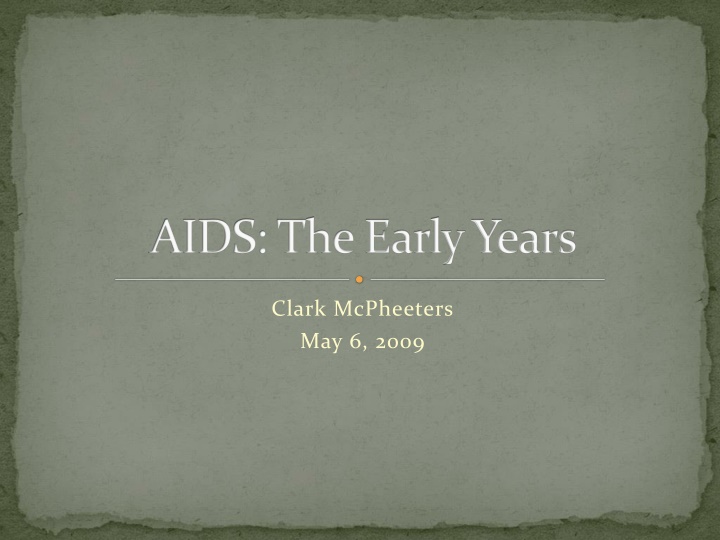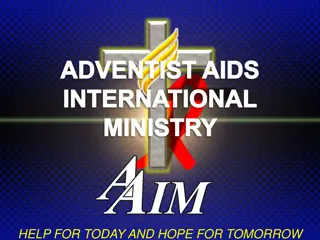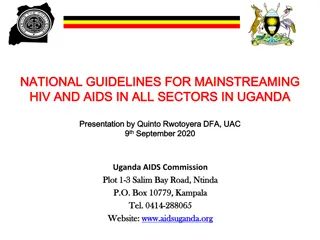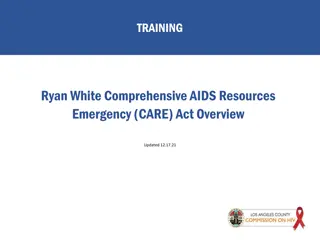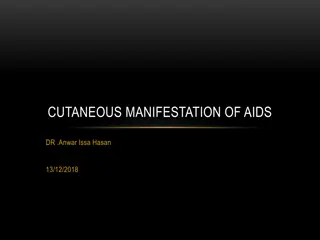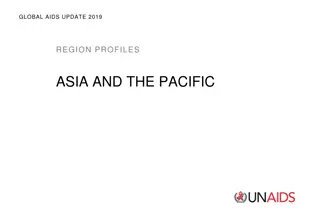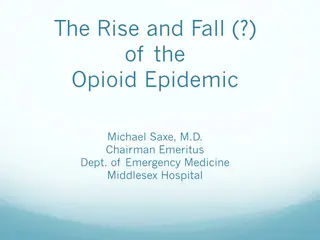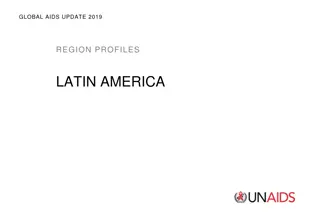Early Years of AIDS Epidemic: Insights and Questions
The early years of the AIDS epidemic from 1980 to 1985, delving into major causes, societal responses, patient perspectives, common misconceptions, and the government's reaction. Discover crucial questions asked and insights gained through extensive research.
Download Presentation

Please find below an Image/Link to download the presentation.
The content on the website is provided AS IS for your information and personal use only. It may not be sold, licensed, or shared on other websites without obtaining consent from the author.If you encounter any issues during the download, it is possible that the publisher has removed the file from their server.
You are allowed to download the files provided on this website for personal or commercial use, subject to the condition that they are used lawfully. All files are the property of their respective owners.
The content on the website is provided AS IS for your information and personal use only. It may not be sold, licensed, or shared on other websites without obtaining consent from the author.
E N D
Presentation Transcript
AIDS: The Early Years Clark McPheeters May 6, 2009
Overview Brief AIDS Timeline, 1980 to 1985 Questions I Asked How I Answered My Questions What Did I Learn, or really, What Is My Argument? How My Work is Significant Conclusions 2
Brief AIDS Timeline, 1980 to 1985 December 23, 1980 the first of many gay men to die of AIDS, Rick Wellikoff, passes away in New York July 28, 1981 the federal government is alerted to the growing epidemic of Pneumocystis pneumonia, now known to be a common secondary infection of AIDS, by a CDC worker named Sandra Ford July 27, 1982 the acronym AIDS (acquired immunodeficiency syndrome) is coined, replacing misnomers such as gay cancer June 14, 1983 Department of Health and Human Services declares AIDS its number-one health priority May 4, 1984 the HIV virus is first linked to AIDS October 2, 1985 actor Rock Hudson dies of AIDS AIDS finally becomes a household name to the American public 3
Questions I Asked What were the major causes of the AIDS epidemic? How did gay men, the federal government, and the media deal with the beginning of the AIDS crisis? How did patients feel about their situation? What misconceptions were common regarding AIDS? Was Gaetan Dugas actually Patient Zero as Randy Shilts, the author of And the Band Played On, claims? How was the federal government alerted of the growing problem? Did the federal government react appropriately? 4
More Questions I Asked Were there external factors and/or internal mindsets that slowed the federal government s response to AIDS? Was the number of AIDS cases just too small by 1982 for the federal government to have taken notice of the epidemic? How/why did media attention differ between AIDS and toxic shock syndrome or Legionnaire s disease? 5
How I Answered My Questions Plenty of interesting reading Journal articles Books Poems Government reports, fact sheets, and publications 6
What I Learned from My Questions, or really, What is My Argument? The major causes of the AIDS epidemic were: The recalcitrance of gays in their newfound sexual freedom The news media s lack of interest in homosexual stories The federal government s sluggish and halfhearted funding for AIDS research Promiscuous sex in bathhouses created prime conditions for the spread of STDs, including the HIV virus Average of 2.7 sexual contacts per night (Shilts 19) One in three chance of contracting gonorrhea or syphilis from an asymptomatic person (Shilts 19) Serial offenders were common (Shilts 19) 7
What Did I Learn from My Questions, or really, What is My Argument? The subjective side of the story is as important as the objective side: June to November of 1981: 788 AIDS cases in thirty-three states were reported (Shilts 200) July 1965 to October 1978: 670 cases of Legionnaire s disease were documented (William H. Forge 616) In 1982, almost 4X more research funding was spent per Legionnaire s case than per AIDS case (Shilts 186) we need the living alive to bucket Ronnie s House with abattoirs of blood / hand in hand lesions across America need to trainwreck the whole show till someone listens (Monette 40) 8
What I Learned from My Questions, or really, What is My Argument? The misnomer gay cancer, coined before the acronym AIDS, caused two detrimental effects: Gay men with the disease thought that it wasn t contagious The media and the American public thought it was just a homosexual disease/issue Gaetan Dugas was not Patient Zero: A man living in what is now the Democratic Republic of Congo in 1959 (Zhu 594) 9
What I Learned from My Questions, or really, What is My Argument? Good intentions led to disaster Don t offend the gays and don t inflame the homophobes. (Shilts 69) CDC MMWR title change (Shilts 68-69): Submitted: Pneumocystis pneumonia in homosexual men Los Angeles (emphasis added) Published: Pneumocystis pneumonia Los Angeles 10
What I Learned from My Questions, or really, What is My Argument? Media attention given to AIDS was anemic compared to toxic shock and Legionnaire s disease The New York Times printed only two stories on AIDS before December 1981 (Shilts 110) Time and Newsweek finally ran their first major stories the same month (Shilts 110) Editors did not want stories about gays and their distasteful sexual habits tarnishing their newspapers (Shilts 110) 11
How My Work is Significant Most authors focus only on objective material or only on subjective material when writing about AIDS and other diseases I sought to draw the two halves of the story together and allow one side to explain/frame/accentuate the other Comparisons are often made between Legionnaire s disease and AIDS, but only in passing I dug into this comparison to see if it had any merit The answer is Yes, it does. 12
Conclusions The dynamics of the early AIDS epidemic cannot be pinned on a single group (gay men, the media, or the federal government) A synergistic effect occurred between these groups: Most gay men were not talking about AIDS to the media Even when the media heard about AIDS, they were not telling the story When senators and representatives heard about AIDS, they would not appropriate money for research Investigating the spread of AIDS from gay men to heterosexuals, particularly injectable drug users and women, would be an interesting next step 13
Questions 14
